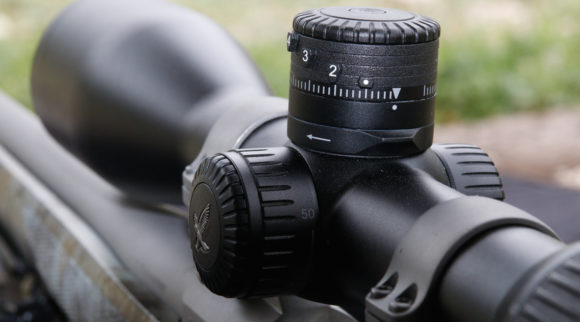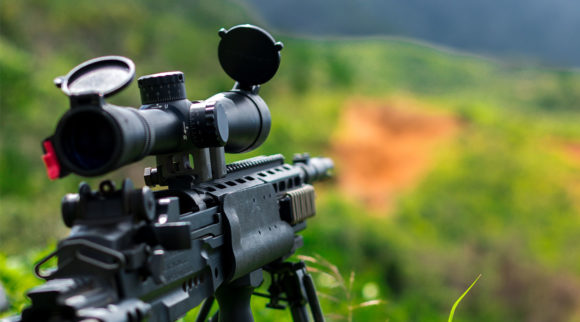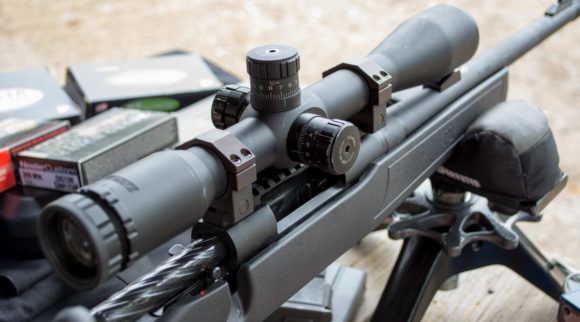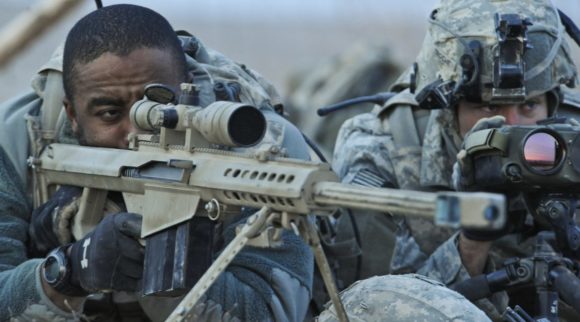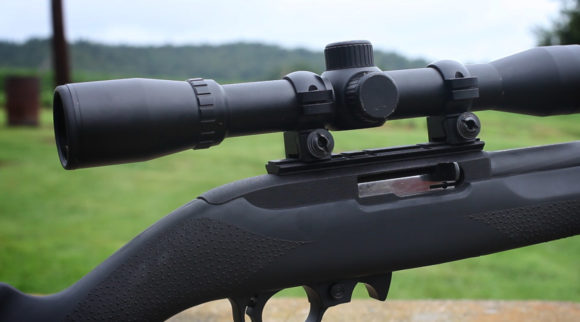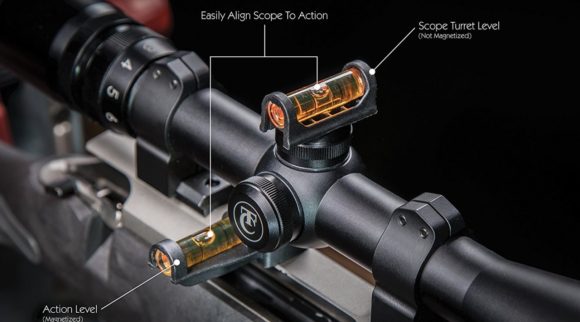Rifle Scope Reticle Types | Sorting Out The Different Reticle Styles

When you’re planning a hunting trip, a rifle scope reticle type is important to consider. A beginner with no prior experience may find the many rifle scope reticle types overwhelming. There are usually many components to fix and more guidelines to follow. Choosing the specific riflescope is as essential as knowing the fundamental parts of your rifle. Often, design, as well as markings, distinguish one scope reticle from another.
Of course, many users say it is the most challenging part of a rifle scope. Others perhaps find it confusing and too practical. This article is focusing on making your preferred activity more satisfying; therefore, rifle scope reticle types will be discussed in detail.
In this Guide
- Scope Reticle Types
- The Suitability of Different Reticle Types
- Features to Consider When Finding the Right Rifle Scope Reticle Type for You
- What is a Scope Reticle?
- Methods of Manufacturing Reticles
- Functions of the Reticle
- Riflescope Reticle Types
- How to Choose the Right Scope Reticle
- Rifle Scope Reticle Types… Cheap? Think Quality Over Cost
- Do You Know Your Rifle Scope?
- Parallax
- Subtension
- Subtension on Front Focal Plane Reticles
- Subtension on the Second/Rear Focal Plane
- Higher Eye Relief
- Coatings for Different Rifle Scope Reticle Types
- Wind and Drop
Scope Reticle Types
Scope Cross Hairs
This scope reticle is the most ingenious of the lot and has been upgraded over the years to serve users better. It is made up of a single horizontal and a single vertical cross hair, both cross and create an aiming point at the center. Manufacturers often make use of simple cross wires to help set the aim point. Also, the windage and elevation lines are on the same plane. Scope crosshairs have maximum ease of use and pinpoint precision. However, if they are not handled carefully, the thinness of the components makes them prone to breakage.
Duplex Reticle
Both beginners and professional hunters will find the duplex reticle easier to work with. Duplex reticles are the enhanced version of crosshairs scopes. They have thin crosshair centers. However, the centers are thicker and denser towards the scope edge, and the four cross hairs thin out so the eye remains drawn to the aiming point. It is more of the all-purpose kind of reticle.
In specific designs, a dot is seen at the center of a duplex reticle to enhance visibility. The dot feature makes it easy for the shooter to focus on a moving target.
Mil Dot Reticle
Designed for long range hunting, snipers and target shooters, the mil dot reticle is a must-have. It also looks like a crosshair but with a significant twist. In place of a line, it has a dot. Usually, the dots are 1-mil apart, so distance is calculated within the reticle. Mil is not for military, 1 –mil is 1/1000 equivalent as in Milli-radian. With the mil dots, the distance between you and the target is easy to figure out.
Military snipers have to deal with mil dot reticles sometimes, and their guns come with 10X scopes. That is why in movies, you often see a side-kick calculating and approximating distance from the target. A miscalculated estimate is equal to missing the mark. In the hands of an inexperienced person, the mil dot reticle is useless.
Even though the reputation of the mil dot reticle precedes it, it is not suitable for every shooter. The element of complexity makes it sometimes difficult to handle. Therefore, excellent knowledge and in-depth calculating skills are required. It compensates for wind drift with accurate delivery.
Leupold Reticle
This is also known as a heavy-duty reticle. Leupold is a brand that is committed to innovative and world-class technology. In fact, their commitment to quality and reliability speak volumes. The Leupold reticle has a direct and straightforward approach to it. External columns are broader and thicker than regular duplex reticles. Best for low light and brushy areas. Leupold custom ballistic reticle is often graduated for certain rifles. Each load is based on a Leupold duplex reticle concept
For a correct aiming point, you should use the intersection of the crosshairs. Beneath these are other dots according to target range per yard. Information on your bullet will come in handy. The user’s guide provides you with the ballistic coefficient, muzzle velocity, and pretty much everything else you need.
BDC Reticle
Bullet drop compensation, or BDC, is a long-range scope reticle for over 500 yards and more. Also, it is optimal for short and middle ranges too. A BDC reticle is essentially a cross hair or duplex reticle with dots as well as markings beneath the center point. Distance is marked as circles, dots, and hash marks.
When a bullet is fired, it flies in the form of an arc and falls. The bullet’s position before the flight is below the center aim as a result of the space between scope and rifle butt. Ballistics flight affords compensation for the bullet drop.
The dot system used here is quite similar to the mil-dot sort, but it comes with a few dots on the 6 o’clock cross hair. BDC reticles may prove complex sometimes as distinctive markings are along the 3 and 6 o’clock cross hairs. Elevation settings of the scope are the most characteristic feature of the BDC.
For instance, vortex reticles of which BDC reticles dead-hold is an example can be used with rifles, shotguns, etc. The same has reference marks that compensate for wind drop or long ranges. Dead-hold uses the second focal plane design.
Christmas Tree Reticle
This type of reticle has a similar shape of a Christmas tree. The hash marks increase in length with every extra marking on the 6’o clock cross hair. This is to accommodate wind drift factors with the shot since the bullet strike and velocity is significantly affected when shooting at long ranges.
The Suitability of Different Reticle Types
Okay, let’s take a breather. That was a lot of information to grasp at once. Actually, it will make you wonder which scope reticle type is useful in which circumstance. Here is what you should know:
Precision shooting readily goes with scope crosshairs. A smaller reticle works fine on a lesser target surface.
For accuracy and precision, clarity and extreme focus on the target, duplex reticles help. A duplex reticle permits the hunter to have a rather easy placement of his mark.
Long-range hunting is usually dependent on the environment. Naturally, BDC reticles work great, but a thin crosshair is also not a bad option.
Any strategic or sniper option require mil dot reticles. Note that mil dot reticles may prove difficult for an unprofessional hunter as a result of the calculation clause.
Features to Consider When Finding the Right Rifle Scope Reticle Type for You
So far, we have established the accuracy scope reticles brings to your shot and the ease they give. We believe the following will shed more light to your scope reticle journey.
Read the manufacturer’s instruction.
Without telling, this is the first thing you should do when you buy a new product. It is easier since your phone can do the work. Watching a video on YouTube might help too if you would prefer not to read.
You should know note the manufacturer’s description of the reticle. The unique features of the reticle are usually visible on the cross hair, entire lens image, or post to signify the bullet drop point, distance pointer, or both. Understand that each distinctive part of the reticle has its own function.
The center point of your reticle is where your bullet will strike. It is necessary to verify the trajectory travel of the particular load in use to make your hit perfect.
It matters whether your reticle is a cross, open, or dot. Dots and lines are distance estimates, and yardage is validated by range. It is important to always double check the scope before you fix a reticle into it.
Thick Scope Crosshairs vs. Thin Scope Crosshairs
Crosshairs and the way your eyes interpret what you see should help guide your choice.
Thick Scope Crosshairs
Many hunters will gladly pick thick crosshairs any day because the target is always quite evident with them. Your eyes are drawn to the aiming point almost immediately. Usually, cross hairs become finer towards the center. They are also excellent for brushy and busy backgrounds especially in low light conditions. Thicker bars are generally a delight to deal with, but they lack the precision of thin cross hairs.
Thin Scope Crosshairs
They are probably the best reticles under this category. It has lesser subtension and finely defined accuracy. Although they are not the best choice for a busy background, crosshairs are made illuminated, which makes for visibility during the day and in the night is also great.
What is a Scope Reticle?
A scope reticle is mostly a form of some markings inside the rifle scope. It is the simple dot that pops up when you’re taking an aim through the rifle scope. In some cases, the design of rifle scope reticle types may determine their model and name. For example, scope cross hairs are originally made up of two thin wires crossing at a distinct point of aim. However, several upgrades make it easier for the shooter to aim and get accurate shots.
Every reticle is designed to maximize and make every shot count. In the beginning, reticles were made from genuine hair or spider web. Nowadays, technological advancement and defines the materials from which they are made. Some are manufactured from wire, etched glass, or other constituents. The wire, which is a predominant part of any reticle, may be silvery but will appear blackish when your target is in focus.
See Top Article: Best Rifle Scope
Methods of Manufacturing Reticles
Holographic rifle scope reticle: this scope reticle uses a holographic image (three-dimensional technology) to establish a fixed range. Illumination is by a collimated laser diode, which completely eliminates the error of parallax. This rifle scope is exclusive to professionals and military personnel even though recreational users are also finding their way around it.
Etched reticles: some of the rifle scope reticle types to be discussed much later have their crosshairs engraved to a tiny bit of glass. Etched reticles may possess floating yet distinct elements that do not interfere with the reticle. Circles and dots are often their center point, and they are designed for long ranges and drift compensation of bullets, as seen in BDC reticles. Glass etched reticles are great, but they are less durable than wire crosshairs.
Illuminated and non-illuminated reticles: illumination is essentially for excellent vision and target locking. Reticles are illuminated by plastic or fiber optic light pipe, powered by LED battery.
Functions of the Reticle
Basically, a rifle scope reticle is straightforward in its primary purpose. It gives you a compact view and aim of your target. Various models (such as a duplex reticle, BDC reticle, etc.) are fit for both stationary and mobile targets; however, the characteristic features of each make them suitable for different environments. For this reason, some reticles will function maximally at the particular hunting activity for which it has been made.
There are reticles for general hunting activities, pig hunting, bullet drop compensation, and many more.
Riflescope Reticle Types
Yes, there are numerous types of reticles in the market. The ever-increasing number of brands differ both in shape and how they are manufactured. Buying just any kind to fit onto your rifle will not cut it. You should instead consider some factors including precision, robustness, hunting conditions, and overall productivity.
For many years, scope crosshairs, also known as plain crosshair reticles, were the choice for many. The simplicity of its shape is easily the reason for this fame. What you see defines the name — when you look through, you’re seeing a “+” symbol. In recent times, with technology and hence the availability of more designs, scope reticles have a more composite and sturdy outlook. The underlying feature is for focus, visibility, range variation as well as navigation.
How to Choose the Right Scope Reticle
Selecting a firearm scope reticle depends on what you want and need. Often, these choices may be influenced by friends, hunting groups, and even the seller. Your choice goes beyond a look or your friend’s testimony. But whether you’re a hunter, target shooter or military person, there will always be thousands of options to consider. First of all, be true to your need and choose for that reason.
A good review goes a long way, but it shouldn’t determine your choice. As a matter of fact, some reticles are available on particular firearms only.
When you begin to do your online research, a lot of scope models and brands will pop up. In fact, it becomes hard to choose. However, you may begin by picking manufacturers that offer high-quality scope. We recommend considering these indices;
- Do you want a closed or open center?
- Do you prefer a well-illuminated scope reticle?
- Does a floating dot seem necessary?
- What resolution do you require?
At the very least, your scope reticle should be fog-proof. You must know that not all scope reticles are designed to withstand adverse weather conditions – heat, moisture, etc.
Furthermore, you should consider these when choosing a design:
Aiming Point: all scope reticles provide an aiming point regardless of its brand. You should consider if it secures your target or shows obscurity.
Assessing Distance: reticles measure the distance between you and the target. A laser range finder requires learning this particular element even though it is great for backup.
Modifying shot placement: when you’re out hunting, there is a chance of missing a shot. It happens to everyone. When you shoot and miss, the reticle can help adjust. This is done by the reticle scale, which shifts the scope to target.
Holdover points: holdover points apply to several ranges. It allows the shooter to focus on the range by using the subtension hash marks. So, for range speed, the target is placed in the subtension hash marks that allow appropriate adjustment. Between the zero points and the shot point is a difference calculated by the reticle. Similarly, aim point changes swiftly from the center to a lower hashmark in relation to variance.
Top Related: Best Scope for 300 Win Mag
Designs: reticle designs can have a relatively simple aiming point like in a duplex reticle. Some are marked with tiny round dots (one milliradian apart). Thicker reticles appear to perform better in low light or clumsy backgrounds. Fine scope crosshairs exhibit invisibility in a busy environment but will help you control shots in minor increments.
For long-range shooters, a bullet drop compensation (BDC) ballistics reticle is opposite. You can holdover between shots. Long range hunting requires different reticle scopes. Object size determines the requirement as it may be small, big or average. You need clarity first.
Rifle Scope Reticle Types… Cheap? Think Quality Over Cost
Quality beats price and quantity any day. First of all, your knowledge on your scope matters. Are you a long-distance shooter? Is your range shorter or longer? This preliminary information will help you narrow down your choice definitive. At this time, you will find it beneficial to know the mounting capacity of your rifle too. Not all scope reticles are used on every kind of gun.
We believe firmly that the cheaper scope reticles are in the market for reasons best known to the manufacturers. As a result of poor craftsmanship, poor outcome, unimportant features as well as failure, these cheap scopes should not be accorded any serious consideration. Often, the deals you get from these sellers are too good to be true. The cheap scopes are a waste of time and effort, and the expensive ones are not always necessary. You will ask, “What do I do?” Your best bet is to go for quality. The scope reticle markets offer price variety; this is often comfortable for a buyer on a budget. You do not have to break the bank after all.
Related: Best Scope Under $500
Do You Know Your Rifle Scope?
Yes, you need to know the basic stuff, especially when you are getting scope reticles soon. Knowing bits about the rifle scope will not hurt. On the other hand, it will decide which scope reticle suits your personal needs.
Objective lens: the objective lens is similar to your camera’s lens. The larger the objective lens is, the more light that enters the scope. Therefore, a larger objective lens is excellent for low light conditions. The front lens is measured in millimeters. The size is found behind scope magnification.
Adjustable objective: this isn’t seen in all scopes. It allows the shooter to control the objective lens focus through a dial fashioned around it. The adjustable objective is better for long range targets and various ranges. Consequently, a shooter will fine tune the focus of the reticle to their optical advantage. Therefore, rifle scopes with no adjustable objective are set to the user’s taste but cannot be adjusted.
Parallax
You will remember this term from physics. Well, the same principle applies. Parallax is the variance between your reticle and the focal plane of the object you’re looking at, so, in simple terms, it is an optical illusion. It tends to muddle up your shots even at long ranges.
As you set your eyes to look through the scope, the scope reticle should remain locked on the target. If you shift your eyes, chances are the reticle shifts with it, so, you fix the error of parallax by a turninaside turret on higher-end scopes.
Note that, some small scopes are parallax free, and some are not. Scopes with parallax often come with adjustable objectives and a form of parallax correction knob. The knob is that part that sets the distance.
Related: Best Scope Under $1000
Subtension
The expanse of distance covered by your reticle with respect to a target is also defined by magnification. Check this out — .1” at 100 yards and mag. Power 20 will have covered .1” of the target. Precise shots go with lower level subtension, meaning a small target needs more attention, regarding visibility. In the same way, thicker crosshairs indicate amplified subtension. These are easily seen and also easily shift your focus from the target.
Subtension on Front Focal Plane Reticles
This indicates that the reticle is in front of the lens. Therefore, an increase or decrease in magnification is equivalent to an increase or decrease in cross hairs size. It is easy because they have similar features to the aperture and lens of a camera.
The cross hairs and center point increase in size as magnification increase giving you a larger image of the target. The cross hairs space remains constant and is compatible with ballistic reticles.
Subtension on the Second/Rear Focal Plane
This points to the opposite of front focal plane. The reticle is found behind the lens. Actually, this design is common amongst hunters. When you increase or decrease magnification, the cross hairs remain the same, but your target appears more evident. For this reason, subtension change is constant. Subtension is still thin and lesser at increasing magnification brackets. Suitable for long distance range and improves precision.
Higher Eye Relief
Scopes do not gather as much light as people think. Instead, they transmit light. Unfortunately, manufacturers measure light transmission in different ways. Old or tired eyes may see less, young and sharper eyes will see more. Eye relief how much you can look through the scope even though your eyes are not set directly. Maximum distance your eyes can be from the ocular. This is important for when you shoot and the firearm recoils, you know your eyes are protected.
Eye reliefs for most rifles are about 4 inches which is great. For pistols and other big models, it is 16 to 20 inches. Intermediate eye reliefs for long guns measure 9 – 12 inches.
Coatings for Different Rifle Scope Reticle Types
Coatings provide all forms of protection for your scope – basically fog-proof, waterproof, and all. They also vary, as you should expect, and depend on your budget.
Single Coated – just one lens surface with at least one layer of coating.
Full coated – only one coating layer covering air to glass surfaces.
Multi-coated – several layers of coating on at least one surface.
Full multi-coated – numerous layers of coating on all air-to-glass surfaces.
What does coating do?
It reduces reflection that causes loss of light or poor light conditions. When it rains, you are covered. Hydrophobic and hydrophilic coatings shed water and give you the perfect view. In addition, some surfaces are abrasion resistant.
Wind and Drop
Every hunter at some time has to deal with the wind and drop. The wind is a natural enemy of your sport. It comes when you least expect, but you should always expect it. Gravity naturally pulls your bullet down, and the wind takes it off the original path. To compensate for this massive disadvantage, you aim higher. Therefore, when you are a little bit higher, the wind directs your bullet precisely to the target.
You can either hold or dial your reticle. The holding technique is to aim higher. You aim to the left or right to account for the wind.
An advantage to the technique is speed. Duplex reticles and crosshairs have a downside to them with the “holding technique,” especially when the target is not in proper sight. In addition, a problem exists – determining or calculating your holding range in either direction. While using a calibrated reticle (mil dot reticles, for example), it is impossible. Your eyes keep shifting off the target towards either side of the reticle. When you need a precise shot, it is trouble.
The “Dialing method” involves tuning your turrets to move the reticle in the interior part of the scope. Mil dot reticles dialing for amendments allows you to hold windage adjustment at the same time. Therefore, elevation adjustment should remain the same while taking a shot, the wind will always cheat you; readjust before another shot.
Related: MRAD vs MOA


